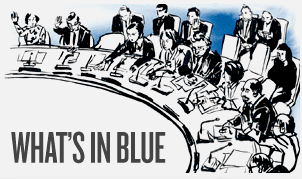Sudan/South Sudan Draft Resolution
Council members are still negotiating a draft resolution addressing the deteriorating relations between Sudan and South Sudan. The US circulated the draft on Thursday (26 April) and a preliminary discussion was held that afternoon at Deputy Permanent Representative (DPR) level. On Friday (27 April) there were negotiations on the draft at both expert and DPR level. It seems a new draft was circulated by the US yesterday. At press time, it seemed that bilateral negotiations were taking place, and it was unclear when agreement would be reached and the resolution adopted.
It seems that the draft resolution supports the 24 April Communiqué of the AU’s Peace and Security Council (PSC) which maps out strict timelines for Sudan and South Sudan to take concrete actions to deescalate the conflict. The AU PSC Communiqué calls on the parties to cease all hostilities within 48 hours, withdraw their forces from the other’s territory, cease support for rebel groups, and redeploy their security forces out of Abyei within two weeks. It also calls on Sudan and South Sudan to establish within one week the Joint Border Verification Monitoring Mission and Secure Demilitarised Border Zone, and immediately cease hostile propaganda and inflammatory statements in the media. It appears that the Security Council’s draft resolution reiterates many of these elements.
It also seems that the draft text, in keeping with the AU PSC Communiqué, emphasises the need for the parties to resolve outstanding issues related to the sharing of oil wealth, protection of each other’s nationals, disputed border territories, and the final status of Abyei.
One element that apparently is in the Council’s draft resolution is a reference to additional measures related to article 41 of the UN Charter, which relates to non-military elements of Chapter VII e.g. economic measures if the parties fail to comply with the resolution.
Given the gravity of the deteriorating relations between Sudan and South Sudan, it appears that some Council members are interested in adopting this resolution expeditiously. The seriousness of the situation on the ground and the prospect of recent events escalating into a broader conflict seem to have galvanised Council members to engage intensively in the negotiations. However, some differences appear to have surfaced in the initial discussions. While there seems to be overall agreement on supporting the AU PSC Communiqué, some members are not comfortable with a resolution which could be interpreted as threatening the use of sanctions in an environment where the Council is trying to encourage negotiations.
There also seem to be concerns among some members that endorsing the tight timeframes outlined in the AU PSC Communiqué for action by Sudan and South Sudan might be unrealistic.
Another area where Council members appear to have a difference of opinion is on how to characterise the recent events in Heglig. Some members appear more inclined to recognise positively South Sudan’s departure from the area, while others seem to prefer to reiterate criticism of South Sudan for its occupation of Heglig on 10 April.
Follow us on Twitter

